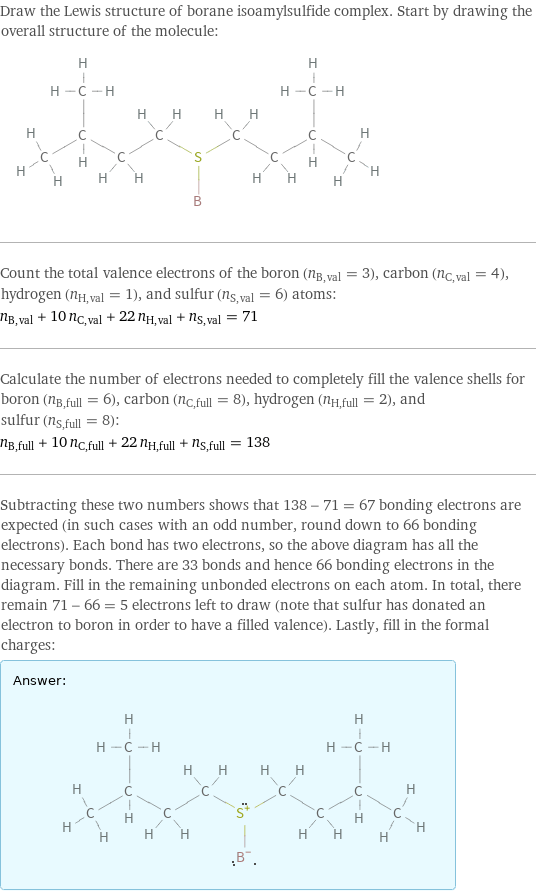Input interpretation

borane isoamylsulfide complex
Chemical names and formulas
![formula | [(CH_3)_2CH_2CH_2]S·BH_3 Hill formula | C_10H_22BS name | borane isoamylsulfide complex IUPAC name | diisopentylsulfonioboron alternate names | bis(3-methylbutyl)sulfonioboron | diisoamylsulfonioboron | diisopentylsulfonioboron | isoamylsulfide borane complex mass fractions | B (boron) 5.84% | C (carbon) 64.9% | H (hydrogen) 12% | S (sulfur) 17.3%](../image_source/9ed4eaacfcba09db0e3679ec24b2f862.png)
formula | [(CH_3)_2CH_2CH_2]S·BH_3 Hill formula | C_10H_22BS name | borane isoamylsulfide complex IUPAC name | diisopentylsulfonioboron alternate names | bis(3-methylbutyl)sulfonioboron | diisoamylsulfonioboron | diisopentylsulfonioboron | isoamylsulfide borane complex mass fractions | B (boron) 5.84% | C (carbon) 64.9% | H (hydrogen) 12% | S (sulfur) 17.3%
Lewis structure

Draw the Lewis structure of borane isoamylsulfide complex. Start by drawing the overall structure of the molecule: Count the total valence electrons of the boron (n_B, val = 3), carbon (n_C, val = 4), hydrogen (n_H, val = 1), and sulfur (n_S, val = 6) atoms: n_B, val + 10 n_C, val + 22 n_H, val + n_S, val = 71 Calculate the number of electrons needed to completely fill the valence shells for boron (n_B, full = 6), carbon (n_C, full = 8), hydrogen (n_H, full = 2), and sulfur (n_S, full = 8): n_B, full + 10 n_C, full + 22 n_H, full + n_S, full = 138 Subtracting these two numbers shows that 138 - 71 = 67 bonding electrons are expected (in such cases with an odd number, round down to 66 bonding electrons). Each bond has two electrons, so the above diagram has all the necessary bonds. There are 33 bonds and hence 66 bonding electrons in the diagram. Fill in the remaining unbonded electrons on each atom. In total, there remain 71 - 66 = 5 electrons left to draw (note that sulfur has donated an electron to boron in order to have a filled valence). Lastly, fill in the formal charges: Answer: | |
Basic properties

molar mass | 185.2 g/mol density | 0.814 g/cm^3
Units

Chemical identifiers
![CAS number | 183118-10-7 PubChem CID number | 16217195 PubChem SID number | 24880053 SMILES identifier | [B-][S+](CCC(C)C)CCC(C)C InChI identifier | InChI=1/C10H22BS/c1-9(2)5-7-12(11)8-6-10(3)4/h9-10H, 5-8H2, 1-4H3 MDL number | MFCD03427258](../image_source/136ea16aff3678a620670d6c4034e1df.png)
CAS number | 183118-10-7 PubChem CID number | 16217195 PubChem SID number | 24880053 SMILES identifier | [B-][S+](CCC(C)C)CCC(C)C InChI identifier | InChI=1/C10H22BS/c1-9(2)5-7-12(11)8-6-10(3)4/h9-10H, 5-8H2, 1-4H3 MDL number | MFCD03427258
Safety properties

flash point | 25 °C